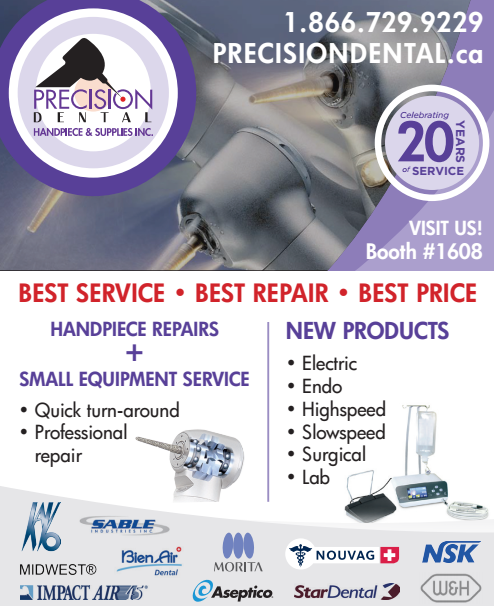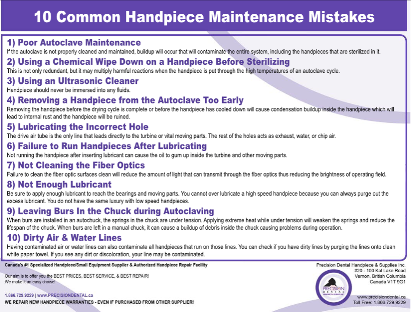Remember This! – As Handpiece Awareness Increases, Repair Costs Decrease!
19 Causes of Premature Handpiece Breakdown and How to Solve Them:
Save thousands by correctly maintaining your dental handpieces.
Some Factors involved are:
Lubrication
O-rings
Purging
Autoclaving
Air pressures
Contamination
Clearing contamination when dark oil is coming from a handpiece
There are 19 Causes of Premature Handpiece Breakdown directly related to the procedures, training and level of care, or lack of it, in dental practices.
It is highly probable the solutions and advice we can offer will immediately reduce dental handpiece repair costs because if the statements by experts are correct, handpiece maintenance is inadequate in seven of every 10 practices.
Contact us today so we can offer ways to help save your practice money!
Spruce up your office with some new Electric Handpieces! Compare your to this picture! Are yours running rough, look all black and chipped or worn out looking? Not using Electrics? Give a demo a try #Electric Handpieces #PrecisionDental #KaVo #NSK
Need help with Maintenance procedures on your E-Type dental handpieces or your electric handpieces? Contact us and we can help go through it with you and save you some money on your handpiece repairs! Maintenance is King! Check out our Highspeed Maintenance sheet. #Maintenance #HandpieceRepair #PrecisionDental
Need help with Maintenance procedures on your dental handpieces? Contact us and we can help go through it with you and save you some money on your handpiece repairs! Maintenance is King! Check out our Highspeed Maintenance sheet. #Maintenance #HandpieceRepair #PrecisionDental
Maintenance is King! Need help with Maintenance procedures on your dental handpieces? Contact us and we can help go through it with you and save you some money on your handpiece repairs! Check this out for Common Mistakes made. #Maintenance #HandpieceRepair #PrecisionDental
Proper Maintenance Saves you money in the long run on your handpiece Maintenance and reduces risk of injury to a patient. Automatic lubricators offer you both ease of use and multiple functions to achieve proper complete cleaning and lubrication.
We look forward to seeing you at the PDC and if you’re not going to be there – No worries! Starting Feb. 15th: Just give us a call or email and get the Same PDC Deals Guaranteed – without the rush. Plus
With it being our 20th Year Anniversary in 2018 – Save up to an Additional 20% Off many Popular Products!
Please call or email for more details.
Common Dental Handpiece Maintenance Mistakes – What is Important to know!
Check out our common Maintenance Mistakes Made to prevent early failure of Dental Handpiece Equipment.
Some Common Ones:
* Not Enough Lubricant
* Failure to Run Dentist Handpieces After Lubricating
* Lubricating the Incorrect Hole Check out the whole article here:
Remember This! – As Handpiece Awareness Increases, Repair Costs Decrease!
19 Causes of Premature Handpiece Breakdown and How to Solve Them:
Save thousands by correctly maintaining your dental handpieces.
Some Factors involved are:
Lubrication
O-rings
Purging
Autoclaving
Air pressures
Contamination
Clearing contamination when dark oil is coming from a handpiece
There are 19 Causes of Premature Handpiece Breakdown directly related to the procedures, training and level of care, or lack of it, in dental practices.
It is highly probable the solutions and advice we can offer will immediately reduce dental handpiece repair costs because if the statements by experts are correct, handpiece maintenance is inadequate in seven of every 10 practices.
Contact us today so we can offer ways to help save your practice money!
Check out our E-flyer coming out tomorrow!
Or Copy Link here:
https://mailchi.mp/6aea542dc092/pdc-2019-deals-precison-dental-handpiece
Precision Dental Winter Warm Up Event – Endo, Slowspeed, Highspeed & Electric
Check us out at:
https://precisiondental.ca
View E-flyer here:
https://mailchi.mp/f50696ef9cce/winter-deals-to-warm-you-up-electrics-highspeeds-from-precision-dental
Call us toll-free at: 1.866.729.9229
OR
Contact us:
https://precisiondental.ca/contact-us/
OR
EMAIL: office@precisiondental.ca
Spruce up your office with some new Electric Handpieces! Compare your to this picture! Are yours running rough, look all black and chipped or worn out looking? Not using Electrics? Give a demo a try #Electric Handpieces #PrecisionDental #KaVo #NSK
Our Mobile site is now live, so now you can book a repair pick up anytime anywhere!
We’re already offering PDC DEALS NOW – so no need to wait and that’s a Guarantee!
Need help with Maintenance procedures on your E-Type dental handpieces or your electric handpieces? Contact us and we can help go through it with you and save you some money on your handpiece repairs! Maintenance is King! Check out our Highspeed Maintenance sheet. #Maintenance #HandpieceRepair #PrecisionDental
Need help with Maintenance procedures on your dental handpieces? Contact us and we can help go through it with you and save you some money on your handpiece repairs! Maintenance is King! Check out our Highspeed Maintenance sheet. #Maintenance #HandpieceRepair #PrecisionDental
Maintenance is King! Need help with Maintenance procedures on your dental handpieces? Contact us and we can help go through it with you and save you some money on your handpiece repairs! Check this out for Common Mistakes made. #Maintenance #HandpieceRepair #PrecisionDental
Proper Maintenance Saves you money in the long run on your handpiece Maintenance and reduces risk of injury to a patient. Automatic lubricators offer you both ease of use and multiple functions to achieve proper complete cleaning and lubrication.
New Product Alert Sale: Endo – Surgical – Restorative – SAVE $$ @ https://precisiondental.ca
https://mailchi.mp/c92f0b16abaa/new-product-alert-sale-endo-surgical-restorative-save-precisiondentalca
Call us toll-free at: 1.866.729.9229
OR
https://precisiondental.ca/contact-us/
OR
EMAIL: office@precisiondental.ca
Blazing Summer Specials “Extended Due to Popular Demand” – from Precision Dental Handpiece Check it out on our blog online at: https://precisiondental.ca/blog-post/precision-dentals-blog/
OR:
https://mailchi.mp/56cfad010453/blazing-summer-specials-extended-due-to-popular-demand-from-precision-dental-handpiece
Check out our latest E-flyer sent out today!
https://precisiondental.ca
OR
https://mailchi.mp/4f910dd8548f/blazing-summer-highspeed-deals-from-precision-dental-handpiece
You can also view it here:
“Best Electric Deal Ever”— (All in One) Electric – Precision Dental – https://mailchi.mp/cb4dd48081dc/best-electric-deal-ever-all-in-one-electric-precision-dental
PDC DEALS @ PRECISON DENTAL HANDPIECE – BOOTH #1608
Check out our latest mail out and be sure to sign up for our Mail List to get great Deals!!
We look forward to seeing you at the PDC and if you’re not going to be there – No worries! Starting Feb. 15th: Just give us a call or email and get the Same PDC Deals Guaranteed – without the rush.

Plus
With it being our 20th Year Anniversary in 2018 – Save up to an Additional 20% Off many Popular Products!
Please call or email for more details.
START TODAY – 2018 WINTER OLYMPICS
Good Luck to our Athletes
Go Canada Go!
HAPPY FAMILY DAY HOLIDAY
Enjoy your weekend with your family and loved ones.
Safe Travels from Precision Dental – Thank You for your support it’s greatly appreciated.
Important:
To serve ALL of our fabulous customers equally Canada Wide – This year we’re OPEN for Business on both of these days!
DATES
Monday Feb. 12th
Happy Family Day (BC)
Monday Feb. 19th
Happy Family Day (AB, SK, ON.)
http://mailchi.mp/c4f913ad2bce/get-up-to-speed-for-2018-happy-new-year-from-precision-dental-handpiece
Get up to Speed for 2018 – Happy New Year from Precision Dental Handpiece
Handpiece Repair Savings + Intro to the New KaVo Electrics !! – http://mailchi.mp/2c68d481ea3c/handpiece-repair-savings-intro-to-the-new-kavo-electrics
Check out our Newest flyer and promotions on Dental handpieces and repairs!

https://precisiondental.ca/limited-time-special-offer/
Happy Holidays from Precision Dental Handpiece – http://mailchi.mp/28618c7a437a/happy-holidays-from-precision-dental-handpiece

Handpiece Repair Savings + Intro to the New KaVo Electrics !!
http://mailchi.mp/2c68d481ea3c/handpiece-repair-savings-intro-to-the-new-kavo-electrics
Common Dental Handpiece Maintenance Mistakes – What is Important to know!
Check out our common Maintenance Mistakes Made to prevent early failure of Dental Handpiece Equipment.
Some Common Ones:
* Not Enough Lubricant
* Failure to Run Dentist Handpieces After Lubricating
* Lubricating the Incorrect Hole
Check out the whole article here:
OR
https://precisiondental.ca/repairs/maintenance-guides/
Check our Newest Flyer Here for Precision Dental Handpiece Specials & Repair Specials:
OR
https://precisiondental.ca/limited-time-special-offer/